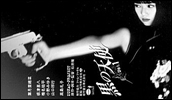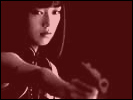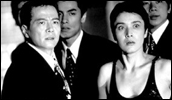Black Angel
- Year
- 1997
- Original title
- Kuro no Tenshi Vol. 1
- Japanese title
- 黒の天使 Vol. 1
- Director
- Cast
- Running time
- 101 minutes
- Published
- 20 March 2001



by Tom Mes
Director Takashi Ishii started out as a manga artist in the seventies after he failed to break into cinema. He came into prominence as the writer of a long-running series of cinematic adaptations of his own adult rape/horror manga Angel Guts (Tenshi no Harawata). The first of these, entitled Angel Guts: High School Coed (Jokosei Tenshi no Harawata), appeared in 1978, directed by Chusei Sone. Ishii took over the directorial reigns of the series ten years later with the fourth installment Angel Guts: Red Vertigo (Tenshi no Harawata: Akai Memai, 1988), finally realising his dream of becoming a filmmaker.
Initially focusing on horror, Ishii moved into gangster action films with 1995's Gonin, which became a festival favourite and made his name internationally. Since then, Ishii has been making fascinating, intrinsically urban action films at a steady rate. The look of his films reflects their urban nature, making the films themselves urban experiences. Characters live in cramped spaces between concrete and steel, on eternally rainswept streets - the pools of water reflecting the neon fluorescence, the claustrophobia further intensified by distinctive, sparse lighting which emphasises small areas in an otherwise dark frame. Black Angel is no exception.
The Black Angel of the title is Mayo, a female assassin who saves Ikko, the six year-old daughter of a yakuza boss, from being massacred along with her entire family at the hands of rival kingpin Nogi. Fourteen years later, the now fully-grown Ikko returns to Japan from the United States to find revenge. Since she calls herself Black Angel, she inevitably clashes with the woman who saved her life all those years ago, but who has now become Nogi's heroin-addicted mistress.
Writer/director Ishii manages to create some ambivalent dynamics between the various characters that populate his tale. In true noir fashion, questions of loyalty and moral ambiguity are raised throughout: the characters that oppose one another also share common experiences that bind them. The story is made of shades of grey instead of black and white, and simply pulling a trigger is rarely an option. The ties that bind the characters give the goings-on a depth of emotion, most strongly felt in an eight-minute sequence, astonishingly shot in a single take without cuts, in which Ikko is beaten and harassed by Nogi and his henchmen, ending in an unsettling rape scene (a scene that both harkens back to the trope of rape that runs through the Angel Guts series and foreshadows Ishii's millennial fall from grace Freeze Me).
In Black Angel Takashi Ishii once again makes abundant use of his characteristic wide-angle lenses, a technique that allows him to have the best of both worlds: it allows him to create an action film which is both claustrophobic and dynamic. The dramatic effect created by camera movement, specifically pans, increases greatly as a result of the distorting wide-angle lens. But this serves another purpose as well. Most of Ishii's films show a fascination with the human body and specifically with body movement. As previously stated, the director works mainly in the genres of sex, horror, and action. The importance of the physical in sex films is evident. Horror's main drive is the vulnerability of the human body, while the action genre is all about movement and expression through the means of body movement. In all three genres, the body communicates the extremes of human emotion under duress. In Ishii's work, all movement is carefully choreographed and lovingly captured, be it in martial arts sequences, gun battles or even dance scenes. Wide-angle lenses distort and elongate the body and especially the limbs, placing even more emphasis on bodies in motion and dirven by emotion.